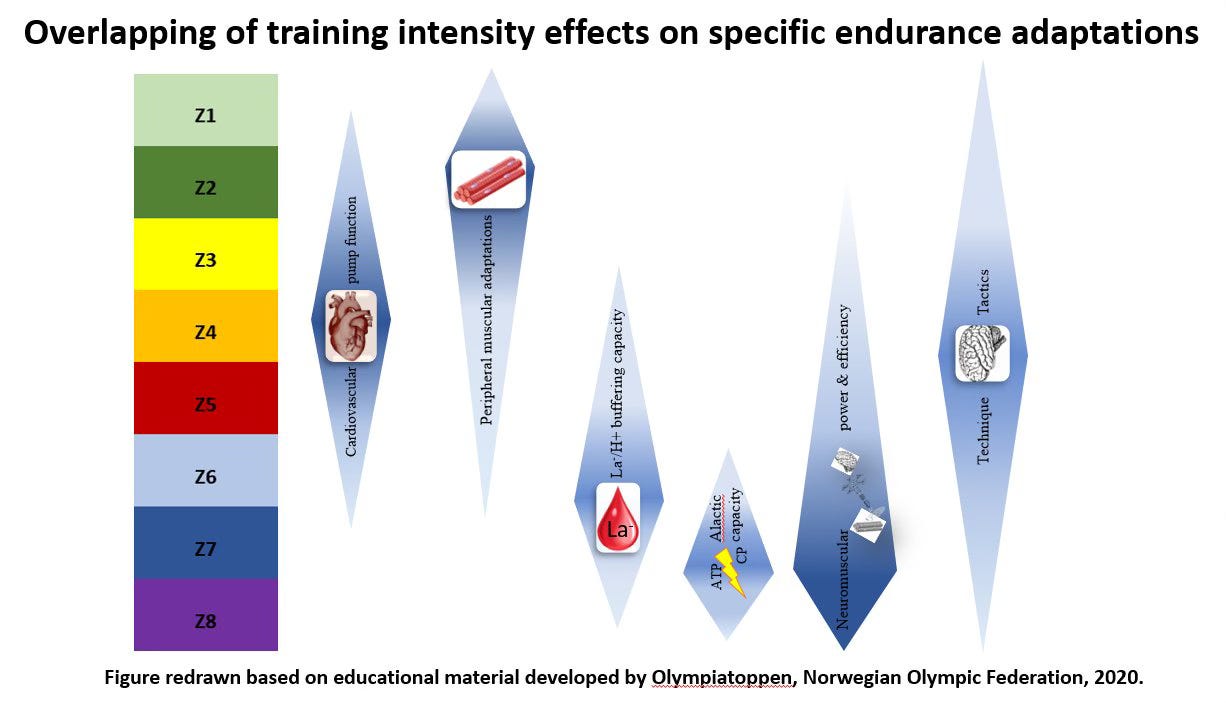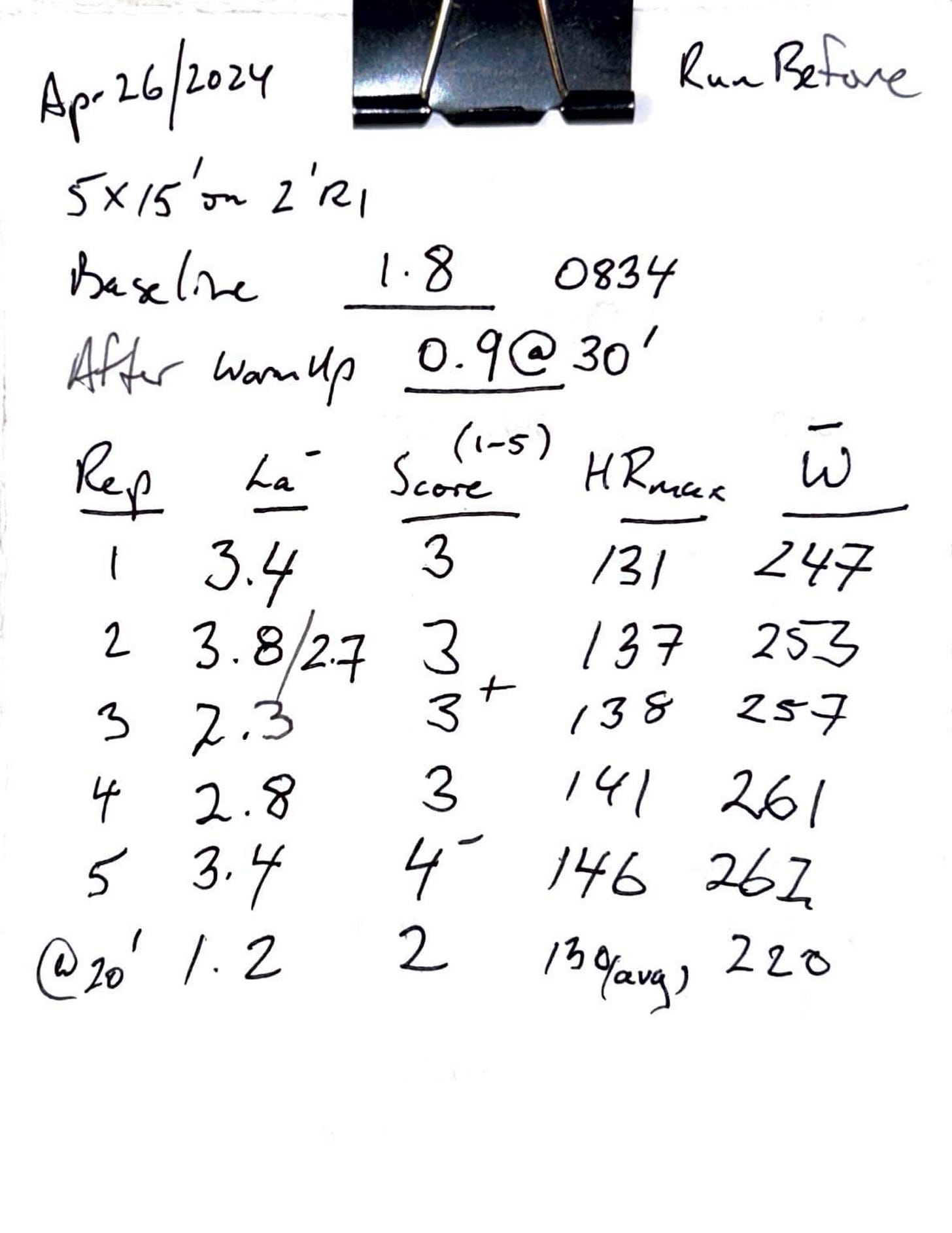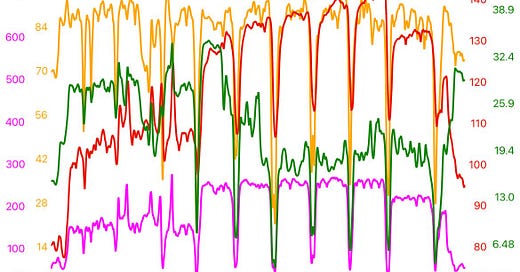I want to step back from sport-specific tips and talk about interval training.
I use intervals inside each of the domains we outlined in our Zones Chapter:
Green Zone - Moderate Domain
Tempo - Heavy Domain
Red Zone - Severe Domain
As you’ll see below, the benefits from training in our zones overlap. However, we can generalize our thinking about the primary purpose of each domain.
Green Zone, Zones 1 & 2 - train our slowtwitch fibers
Tempo, Zone 3 - train our intermediate fibers
Red Zone, Zones 4, 5 and beyond - max out all our fibers (slow, intermediate and fast)
There are a host of benefits from endurance training (see Stephen Seiler’s slide below). The slide comes from Stephen’s chapter inside Endurance Training, Science and Practice. If you have a passion for endurance sport then the book is worth your time.

Start With The End In Mind
Let’s assume your coach, or your favorite endurance writer, gives you an interval session to complete.
Before you start, pause and consider:
What's the goal of this session?
What domain/zone are we targeting?
It’s important to understand the answer before you head out the door. Once our heart rate is up, it becomes more difficult to think clearly.
The domains make our job easier…
Endurance Session - keep it in the Green Zone, build ourselves up.
Tempo Session - challenge our intermediate fibers, avoid multi day recovery (called strain).
Red Zone Session - directly target VO2max adaptations, understand these sessions often require extended recovery.
Think in terms of DAYS not main sets.
Is this an Endurance, Tempo or VO2 day?
By understanding the nature of the day:
You will have better execution of the session.
You will be able to take a holistic view of the training week and remember most DAYS should be “Green.”
As you learn your relative tolerances for each domain, you will be able to balance between the three types of days.
Winning The Day
I’m going to use a bike workout to explain how to better execute your intervals.
It was “Tempo Day” in my program.
Peppy Run
Peppy Ride
The ride included 5x15 minutes Tempo on 2 minutes recovery.
The primary goal of the DAY was to challenge my intermediate fibers.
Because of the total duration of the day, there is an endurance effect. However, this is not a “Green” or “Endurance” day.
Going into Zone 3+ makes the day stressful and I’ll need to watch my recovery afterwards.
If I get carried away (and head into Zones 4 & 5) then recovery will be extended.
Combining the run and bike, there was 90 minutes of Tempo training. Done too intensely, that dose will end my week.1
We win the day by:
Achieving Our Primary Objective => stressing intermediate fibers
Not Screwing Up Tomorrow, and the following day(s)
Key Components For Success
Warm Up
Intensity Control
Early HR
Feel
Kinetics
Avoiding Strain
Warm Up: know what works for you. I like a long warm up (links to my article) and had 2.5 hours of exercise completed before I started the main set for the bike.
I’m at the extreme end of warm-up duration. If you feel ready to go with a short warm-up with a few pickups then that’s fine.
Intensity Control: with the more intense training zones (Zone 4 & 5 in particular), heart rate is a poor indicator of effort. This is most noticeable at the beginning of a long interval set. “Long” being relative to the training intensity zone.2

Knowing heart rate will lag effort, use feeling/power/pace to avoid overcooking the early interval.
What I tell myself:
The first interval is all downside.
If I go too hard then I may ruin the entire set.
Stay in the desired domain, settle in.
Remember you can always pick up effort, later.
Don’t push heart rate early. If you do then you’ll change the nature of the set.
Leave a cushion in the heart rate, and subjective perception, for the set to become more difficult later.
With Green Zone and Tempo Training, we are seeking stability. Meaning there isn’t a constant increase in feeling, heart rate or lactate.
You can see in the data table, I did not get this correct. I felt, and the data shows, a change around 260 watts. Just like with training zones, be willing to adjust targets downwards when indicated by training data.
Avoiding Strain: Immediately after training, we will usually feel great. Keep watching what happens in the 24-48 hours following.
While I pushed the final two intervals a little too hard, I absorbed the session fine and my week continued as planned.
That was not the case a year prior. When I first tried this type of session my heart rate and feeling rocketed immediately… …and kept climbing. The session wiped me out for days. If you experience something similar then it is usually a sign general capacity is lacking.
A year ago, a lack of Basic Fitness was my diagnosis. I dropped the Tempo from my program and continued to focus on improving my Green Zone performance.
Keeping It Simple
The numbers keep my mind engaged in a hobby that is predictable and repetitive.
But…
The default system is Subjective Perception.
And…
We need to remember four things:
Don’t Push Early
Leave Room For Later
Score Each Interval (1 to 5)3
Judge The Session By What Happens Afterwards
We’re going to be stacking workouts for the rest of our lives.
In the unlikely event we goo too easy, we have plenty of time to make adjustments.
Back To Table of Contents
When using Zones 3, 4 and 5, be conservative with targets and dosing. The most effective protocols are progressive in terms of: (a) in-session targets; and (b) total session load.
Dosing: our swim and run chapters give workouts/main sets for various intensity zones and races. In our up-coming bike chapter, we will do the same.
Big Picture: when you are above your Green Zone, be cautious and skew errors left/down. Always leave room to be strong at the end, and enable progress next time. Save your best efforts for race day.
Loading errors are inevitable. Learn from them and be willing to back off. Spread the "tough stuff” out across your week and monthly cycles.
Match the score to the day. Endurance days should feel 1 or 2. Tempo Days are a 3. Red Zone days are 4 or 5-. Save the 5 and 5+ for races.



